Intel Xeon E5-2697 v2 and Xeon E5-2687W v2 Review: 12 and 8 Cores
by Ian Cutress on March 17, 2014 11:59 AM EST- Posted in
- CPUs
- Intel
- Xeon
- Enterprise
Real World CPU Benchmarks
Rendering – Adobe After Effects CS6: link
Published by Adobe, After Effects is a digital motion graphics, visual effects and compositing software package used in the post-production process of filmmaking and television production. For our benchmark we downloaded a common scene in use on the AE forums for benchmarks and placed it under our own circumstances for a repeatable benchmark. We generate 152 frames of the scene and present the time to do so based purely on CPU calculations.
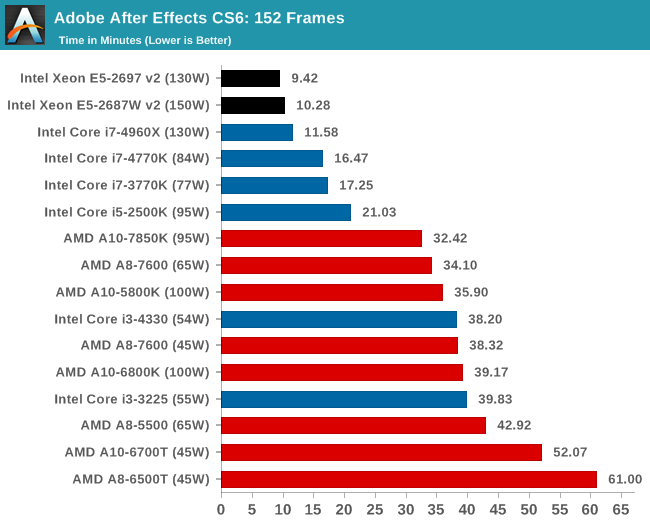
With AE6 being an optimized software package, more cores and threads rather than more MHz makes sense in our test.
Compression – WinRAR 5.0.1: link
Our WinRAR test from 2013 is updated to the latest version of WinRAR at the start of 2014. We compress a set of 2867 files across 320 folders totaling 1.52 GB in size – 95% of these files are small typical website files, and the rest (90% of the size) are small 30 second 720p videos.
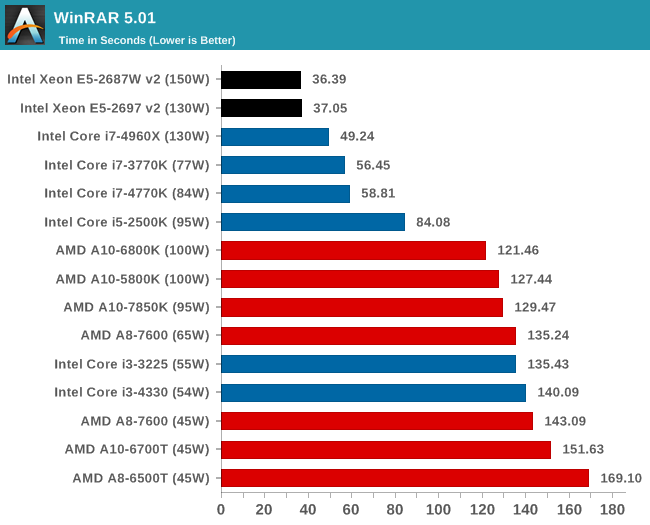
Due to the variable nature of the WinRAR test, our Xeons come out on top but it is hard to choose between them.
Image Manipulation – FastStone Image Viewer 4.9: link
Similarly to WinRAR, the FastStone test us updated for 2014 to the latest version. FastStone is the program I use to perform quick or bulk actions on images, such as resizing, adjusting for color and cropping. In our test we take a series of 170 images in various sizes and formats and convert them all into 640x480 .gif files, maintaining the aspect ratio. FastStone does not use multithreading for this test, and thus single threaded performance is often the winner.
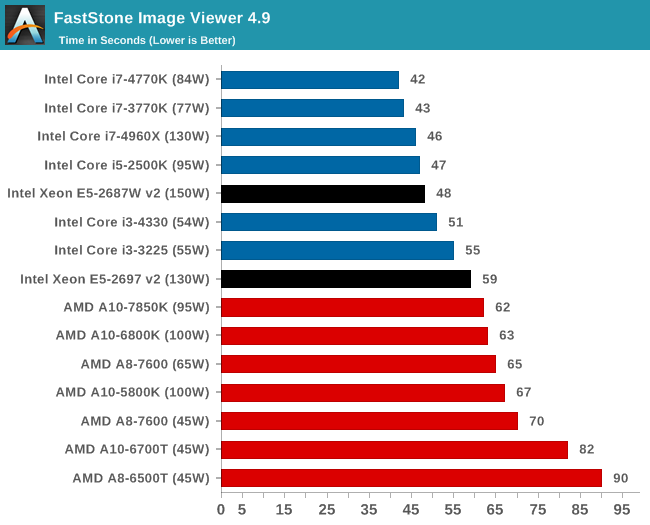
FastStone is a single threaded application where IPC and MHz matter. As a result, the newest architectures and platforms do better here than the Ivy Bridge-E based Xeons.
Video Conversion – Xilisoft Video Converter 7: link
The XVC test I normally do is updated to the full version of the software, and this time a different test as well. Here we take two different videos: a double UHD (3840x4320) clip of 10 minutes and a 640x266 DVD rip of a 2h20 film and convert both to iPod suitable formats. The reasoning here is simple – when frames are small enough to fit into memory, the algorithm has more chance to apply work between threads and process the video quicker. Results shown are in seconds and time taken to encode.

When going through lots of small frames, our XVC test working on one file prefers cores and threads over MHz.

When the workload has some room to grow with larger frames, segments of each frame can be dispatched to cores more approprately and the 12-core Xeon comes out on top.
Video Conversion – Handbrake v0.9.9: link
Handbrake is a media conversion tool that was initially designed to help DVD ISOs and Video CDs into more common video formats. The principle today is still the same, primarily as an output for H.264 + AAC/MP3 audio within an MKV container. In our test we use the same videos as in the Xilisoft test, and results are given in frames per second.
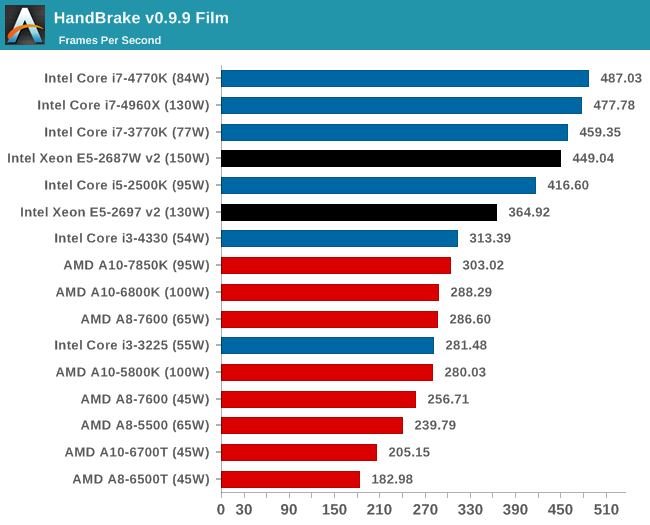
Similar to the XVC test, when the frames are small the software has to fight against thread dispatch of smaller pieces that get in the way of opening up the trottle.
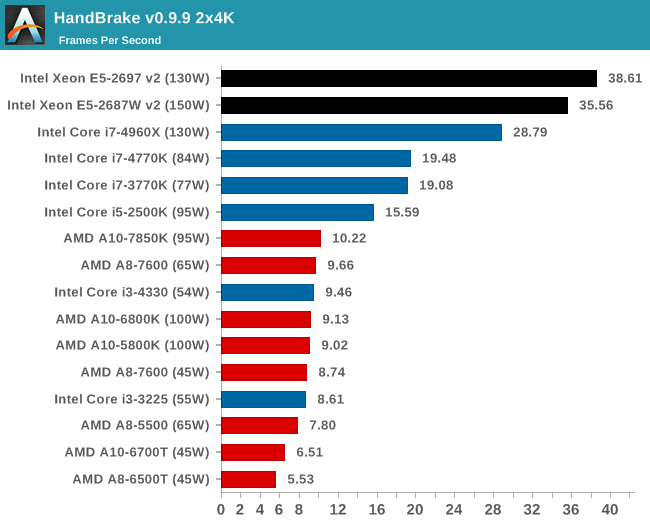
Move to larger frames again and the Xeons can use their full force. Cores over MHz wins here.
Rendering – PovRay 3.7: link
The Persistence of Vision RayTracer, or PovRay, is a freeware package for as the name suggests, ray tracing. It is a pure renderer, rather than modeling software, but the latest beta version contains a handy benchmark for stressing all processing threads on a platform. We have been using this test in motherboard reviews to test memory stability at various CPU speeds to good effect – if it passes the test, the IMC in the CPU is stable for a given CPU speed. As a CPU test, it runs for approximately 2-3 minutes on high end platforms.
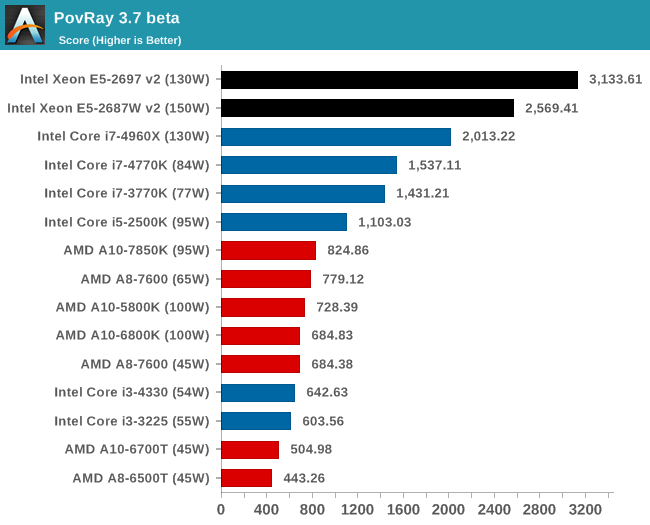
PovRay becomes an embarrassingly parallel benchmark where cores x frequency come out on top. This pattern of results is a common sight in our synthetic testing.










71 Comments
View All Comments
Ian Cutress - Tuesday, March 18, 2014 - link
I need to spend some time to organise this with my new 2014 benchmark setup. That and I've never used bench to add data before. But I will be putting some data in there for everyone :)Maxal - Tuesday, March 18, 2014 - link
There is one sad thing - disappearance of 2C/4T high clock speed CPUs, as Oracle Enterprise Edition charges by cores.....and sometimes you need just small installation but with EE features...Rick83 - Tuesday, March 18, 2014 - link
Wouldn't L3/thread be a more useful metric than L3/core in the big table?HT will only really work after all, if both threads are in cache, and if you can get a CPU with HT and one without, as is the case with the Xeons, you'd get the one without because you are running more concurrent threads. That means that under optimum conditions, you have 2 threads per core that are active, and thus 2x#cores threads that need to be in the data caches.
HalloweenJack - Tuesday, March 18, 2014 - link
holy shit anandtech you really have gone to the dogs - comparing a £2000 cpu against a £100 apu and saying its better..... and really? wheres the AMD AM3+ cpu`s? 8350 or 9590? seriouslyIan Cutress - Tuesday, March 18, 2014 - link
Let's see. I'm not comparing it against a £100 APU, I'm comparing it against the $1000 Core i7-4960X to see the difference. We're using a new set of benchmarks for 2014, which I have already run on the APU so I include them here as a point of reference for AMD's new highest performance line. It is interesting to see where the APU and Xeon line up in the benchmarks to show the difference (if any). AMD's old high end line has stagnated - I have not tested those CPUs in our new 2014 set of benchmarks. There have been no new AM3+ platforms or CPUs this year, or almost all of last year. Testing these two CPUs properly took the best part of three weeks, including all the other work such as news, motherboard reviews, Mobile World Congress coverage, meetings, extra testing, bug fixing, conversing with engineers on how to solve issues. Sure, let's just stop all that and pull out an old system to test. If I had the time I really would, but I was able to get these processors from GIGABYTE, not Intel, for a limited time. I have many other projects (memory scaling, Gaming CPU) that would take priority if I had time.AKA I think you missed the point of the article. If you have a magical portal to Narnia, I'd happily test until I was blue in the face and go as far back to old Athlon s939 CPUs. But the world moves faster than that.
deadrats - Tuesday, March 18, 2014 - link
any chance of updating this article with some x265 and/or Divx265 benchmarks? hevc is much more processor intensive and threading friendly, so these encoders may be perfect for showing a greater separation between the various core configurations.Ian Cutress - Tuesday, March 18, 2014 - link
If you have an encoder in mind drop me an email. Click my name at the top of the article.bobbozzo - Tuesday, March 18, 2014 - link
Hi,1. please change the charts' headings on the first page to say 'Cores/Threads' instead of 'Cores'.
2. it wasn't clear on the first page that this is talking about workstation CPUs.
3. "Intel can push core counts, frequency and thus price much higher than in the consumer space"
I would have said core counts and cache...
Don't the consumer parts have the highest clocks (before overclocking)?
Thanks!
bobbozzo - Tuesday, March 18, 2014 - link
"it wasn't clear on the first page that this is talking about workstation CPUs."As opposed to servers.
Ian Cutress - Tuesday, March 18, 2014 - link
1) I had it that way originally but it broke the table layout due to being too wide. I made a compromise and hoped people would follow the table in good faith.2) Generally Xeon in the name means anything Workstation and above. People use Xeons for a wide variety of uses - high end for workstaitons, or low end for servers, or vice versa.
3) Individual core counts maybe, but when looking at 8c or 12c chips in the same power bracket, the frequency is still being pushed to more stringent requirements (thus lower yields/bin counts) vs. voltages. Then again, the E3-1290 does go to 4.0 GHz anyway, so in terms of absolute frequencies you can say (some) Xeons at least match the consumer parts.